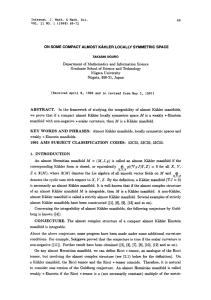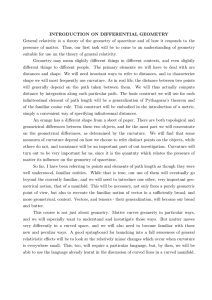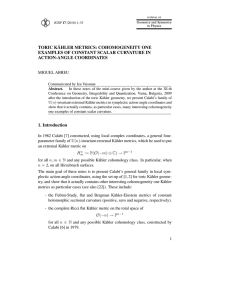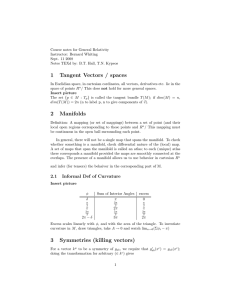A REMARK ON FOUR-DIMENSIONAL ALMOST KÄHLER-EINSTEIN MANIFOLDS WITH NEGATIVE SCALAR CURVATURE
advertisement
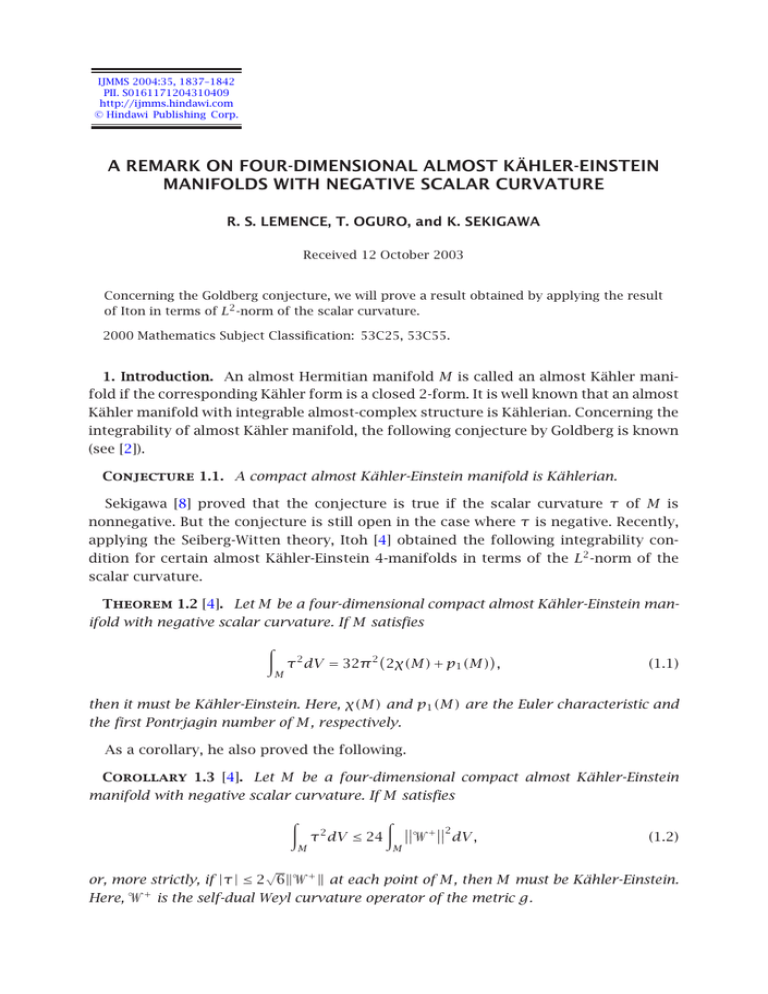
IJMMS 2004:35, 1837–1842
PII. S0161171204310409
http://ijmms.hindawi.com
© Hindawi Publishing Corp.
A REMARK ON FOUR-DIMENSIONAL ALMOST KÄHLER-EINSTEIN
MANIFOLDS WITH NEGATIVE SCALAR CURVATURE
R. S. LEMENCE, T. OGURO, and K. SEKIGAWA
Received 12 October 2003
Concerning the Goldberg conjecture, we will prove a result obtained by applying the result
of Iton in terms of L2 -norm of the scalar curvature.
2000 Mathematics Subject Classification: 53C25, 53C55.
1. Introduction. An almost Hermitian manifold M is called an almost Kähler manifold if the corresponding Kähler form is a closed 2-form. It is well known that an almost
Kähler manifold with integrable almost-complex structure is Kählerian. Concerning the
integrability of almost Kähler manifold, the following conjecture by Goldberg is known
(see [2]).
Conjecture 1.1. A compact almost Kähler-Einstein manifold is Kählerian.
Sekigawa [8] proved that the conjecture is true if the scalar curvature τ of M is
nonnegative. But the conjecture is still open in the case where τ is negative. Recently,
applying the Seiberg-Witten theory, Itoh [4] obtained the following integrability condition for certain almost Kähler-Einstein 4-manifolds in terms of the L2 -norm of the
scalar curvature.
Theorem 1.2 [4]. Let M be a four-dimensional compact almost Kähler-Einstein manifold with negative scalar curvature. If M satisfies
M
τ 2 dV = 32π 2 2χ(M) + p1 (M) ,
(1.1)
then it must be Kähler-Einstein. Here, χ(M) and p1 (M) are the Euler characteristic and
the first Pontrjagin number of M, respectively.
As a corollary, he also proved the following.
Corollary 1.3 [4]. Let M be a four-dimensional compact almost Kähler-Einstein
manifold with negative scalar curvature. If M satisfies
M
τ 2 dV ≤ 24
M
+ 2
ᐃ dV ,
(1.2)
√
or, more strictly, if |τ| ≤ 2 6ᐃ+ at each point of M, then M must be Kähler-Einstein.
Here, ᐃ+ is the self-dual Weyl curvature operator of the metric g.
1838
R. S. LEMENCE ET AL.
In this paper, concerning the Goldberg conjecture, we will prove a result obtained by
using Corollary 1.3 (see Theorem 2.2).
2. Preliminaries and the result. Let M = (M, J, g) be a four-dimensional almost
Kähler-Einstein manifold with the almost-complex structure J and the Hermitian metric
g. We denote by Ω the Kähler form of M defined by Ω(X, Y ) = g(X, JY ) for X, Y ∈ X(M),
the set of all smooth vector fields on M. We assume that M is oriented by the volume
form dV = Ω2 /2. We denote by ∇, R, ρ, and τ the Riemannian connection, the curvature
tensor, the Ricci tensor, and the scalar curvature of M, respectively. We assume that
the curvature tensor is defined by R(X, Y )Z = [∇X , ∇Y ]Z − ∇[X,Y ] Z for X, Y , Z ∈ X(M).
We denote by ρ ∗ the Ricci ∗-tensor of M defined by
ρ ∗ (x, y) =
1
trace of z → R(x, Jy)Jz
2
(2.1)
for x, y, z ∈ Tp M, the tangent space of M at p ∈ M. The Ricci ∗-tensor satisfies ρ ∗ (x,
y) = ρ ∗ (Jy, Jx) for any x, y ∈ Tp M, p ∈ M. We note that if M is Kählerian, the Ricci
tensor and the Ricci ∗-tensor coincide on M. The ∗-scalar curvature τ ∗ of M is the
trace of the linear endomorphism Q∗ defined by g(Q∗ x, y) = ρ ∗ (x, y) for x, y ∈ Tp M,
p ∈ M. Since ∇J2 = 2(τ ∗ −τ), M is a Kähler manifold if and only if τ ∗ −τ = 0 on M. An
almost Hermitian manifold M is called a weakly ∗-Einstein manifold if ρ ∗ = λ∗ g (λ∗ =
τ ∗ /4) and a ∗-Einstein if M is weakly ∗-Einstein with constant ∗-scalar curvature. The
following identity holds for any four-dimensional almost Hermitian Einstein manifold:
τ∗
1 ∗
ρ (x, y) + ρ ∗ (y, x) =
g(x, y)
2
4
(2.2)
for x, y ∈ Tp M, p ∈ M.
Now, let ∧2 M be the vector bundle of all real 2-forms on M. The bundle ∧2 M inherits
a natural inner product g and we have an orthogonal decomposition
1,1
∧2 M = RΩ ⊕ LM ⊕ ∧0 M,
(2.3)
1,1
where LM (resp., ∧0 M) is the bundle of J-skew-invariant (resp., J-invariant) 2-forms
1,1
on M perpendicular to Ω. We can identify the subbundle RΩ ⊕ LM (resp., ∧0 M) with
2
2
the bundle ∧+ M (resp., ∧− M) of self-dual (resp., anti-self-dual) 2-forms on M. Since M
is Einstein, it is well known that the curvature operator : ∧2 M → ∧2 M preserves ∧2± M
and that the Weyl curvature operator ᐃ : ∧2 M → ∧2 M is given by
τ
ᐃ ι(X) ∧ ι(Y ) = ι(X) ∧ ι(Y ) −
ι(X) ∧ ι(Y ),
12
(2.4)
where ι is the duality between the tangent bundle and the cotangent bundle of M by
means of the metric g. Let {e1 , e2 = Je1 , e3 , e4 = Je3 } be a (local) unitary frame field and
put ei = ι(ei ). Then, the Kähler form is represented by Ω = −e1 ∧ e2 − e3 ∧ e4 . Further,
A REMARK ON FOUR-DIMENSIONAL ALMOST KÄHLER-EINSTEIN MANIFOLDS
1839
we see that
1 1 {Φ, JΦ} = √ e1 ∧ e3 − e2 ∧ e4 , √ e1 ∧ e4 + e2 ∧ e3 ,
2
2
(2.5)
1 1
1 1 1
2
3
4
3
Ψ 1 , Ψ2 , Ψ3 = √ e ∧ e − e ∧ e , √ e ∧ e + e 2 ∧ e 4 , √ e 1 ∧ e 4 − e 2 ∧ e 3
2
2
2
1,1
are (local) orthonormal bases of LM and ∧0 M = ∧2− M, respectively.
In this paper, for any orthonormal basis (resp., any local orthonormal frame field)
{e1 , e2 , e3 , e4 } of a point p ∈ M (resp., on a neighborhood of p), we will adopt the following notational convention:
Jij = g Jei , ej ,
Γijk = g ∇ei ej , ek ,
Rijkl = g R ei , ej ek , el , . . . , Rīj̄ k̄l̄ = g R Jei , Jej Jek , Jel ,
ρij = ρ ei , ej , . . . , ρīj̄ = ρ eī , ej̄ ,
(2.6)
∗
ρij
= ρ ∗ ei , ej , . . . , ρī∗j̄ = ρ ∗ eī , ej̄ ,
∇i Jjk = g ∇ei J ej , ek , . . . , ∇ī Jj̄ k̄ = g ∇eī J ej̄ , ek̄ ,
and so on, where the Latin indices run over the range 1, 2, 3, 4. We define functions A,
B, C, D, G, and K on M by
A=
4
∇a Jij Rijkl ∇a Jkl ,
i,j,k,l,a=1
B=
4
∇a Jij ∇a Jkl ∇b Jij ∇b Jkl ,
i,j,k,l,a=1
C=
4
Rijkl Rij̄kl̄ ,
i,j,k,l=1
4
∗
∗ 2
,
G=
ρij − ρji
D=
4
2
Rijkl − Rij k̄l̄ ,
(2.7)
i,j,k,l=1
K = (u − v)2 + 4w 2 ,
i,j=1
where u = g((Φ), Φ), v = g((JΦ), JΦ), and w = g((Φ), JΦ). First, we will prove the
following.
Lemma 2.1. The norm of the self-dual Weyl operator ᐃ+ is given by
2
+ 2
ᐃ = 1 G + D + τ ∗ 2 − τ .
16
3
(2.8)
Proof. Let {e1 , e2 = Je1 , e3 , e4 = Je3 } be any (local) unitary frame field on M and
√
√
√
we put Ω0 = −Ω/ 2 = (e1 ∧ e2 + e3 ∧ e4 )/ 2, Φ = (e1 ∧ e3 − e2 ∧ e4 )/ 2, and JΦ =
√
(e1 ∧e4 +e2 ∧e3 )/ 2. Then, {Ω0 , Φ, JΦ} is an orthonormal basis of ∧2+ M. Thus, we have
+ 2
ᐃ = g ᐃ+ Ω0 , Ω0 2 + g ᐃ+ Ω0 , Φ 2 + g ᐃ+ Ω0 , JΦ 2
2
2
2
+ g ᐃ+ (Φ), Ω0 + g ᐃ+ (Φ), Φ + g ᐃ+ (Φ), JΦ
2
2
2
+ g ᐃ+ (JΦ), Ω0 + g ᐃ+ (JΦ), Φ + g ᐃ+ (JΦ), JΦ .
(2.9)
1840
R. S. LEMENCE ET AL.
Taking account of (2.4), we have
1
τ
1 ∗
g ᐃ + Ω0 , Ω0 =
− R1212 − 2R1234 − R3434 −
=
3τ − τ ,
2
6
12
1
1 ∗
∗
g ᐃ + Ω0 , Φ =
,
− R1213 − R1224 − R3413 − R3424 = − ρ14
− ρ41
2
2
1
1 ∗
∗
g ᐃ+ Ω0 , JΦ =
,
− R1214 − R1223 − R3414 − R3423 =
ρ13 − ρ31
2
2
1
τ
τ
− R1313 + 2R1324 − R2424 −
= − R1313 − R1324 −
,
g ᐃ+ (Φ), Φ =
2
6
12
1
g ᐃ+ (Φ), JΦ =
− R1314 − R1323 + R2414 + R2423 = − R1314 + R1323 ,
2
τ
1
τ
− R1414 − 2R1423 − R2323 −
= − R1414 + R1423 −
.
g ᐃ+ (JΦ), JΦ =
2
6
12
(2.10)
Thus, we have
2
+ 2
ᐃ = 1 3τ ∗ − τ 2 + 2τ + 1 ρ ∗ − ρ ∗ 2 + 1 ρ ∗ − ρ ∗ 2
13
31
14
41
2
2
12
12
2
2
2 2 2
+ R1313 − R1324 + R1314 + R1323 + R1314 + R1323
2 τ + R1414 + R1423 +
R1313 − R1324 + R1414 + R1423
6
2 2τ 2 G
1 ∗
=
+
3τ − τ +
122
122
8
2 1 2
1
Rijkl − Rij k̄l̄ −
R12kl − R12k̄l̄
+
4 i<j, k<l
4 k<l
2 τ
τ
1 − − R1212 − R1234
−
R34kl − R34k̄l̄ +
4 k<l
6
4
2 2τ 2 G D
G
G
τ
τ τ∗
1 ∗
3τ
+
−
−
+
−
+
=
−
τ
+
+
122
122
8 16 32 32 6
4
4
∗ 2
G
τ
τ2
D
+
+
−
.
=
16 16
16
48
(2.11)
The lemma follows.
Next, we recall the following equalities established in [6]:
2
∗
τ −τ
1
B=
,
4
2
2
∗
τ −τ
C = −2K +
,
8
2 2
∗ 2 ∗ 2 + ρ14
,
G = 4ρ ∗ − τ ∗ = 16 ρ13
2
∗
τ −τ
K = (u + v)2 + 4 w 2 − uv =
,
− 4 det LM
16
2
LM = 1 D,
2 = 1 (D − G),
LM
16
16
A=
(2.12)
A REMARK ON FOUR-DIMENSIONAL ALMOST KÄHLER-EINSTEIN MANIFOLDS
1841
= PLM ◦ LM , the composition of LM
where LM is the restriction of to LM and LM
2
and the natural projection PLM : ∧ M → LM. We define a vector field η = (ηa ) on M by
4
ηa = i,j=1 (∇a Jij )ρi∗j̄ , then we obtain the following (see [6, (2.23)]):
∆τ ∗ =
∗
3τ − τ τ ∗ − τ
G
+ 4K +
− 4 div η.
2
4
(2.13)
Further, from (2.12) and the curvature identity
Rijkl − Rij k̄l̄ − Rīj̄kl + Rīj̄ k̄l̄ + Rīj k̄l + Rījkl̄ + Rij̄ k̄l + Rij̄kl̄ = 2
4
∇a Jij ∇a Jkl
(2.14)
a=1
by Gray [3] for almost Kähler manifold, we have
A=
=
=
=
=
1
Rijkl Rijkl − Rij k̄l̄ − Rīj̄kl + Rīj̄ k̄l̄ + Rīj k̄l + Rījkl̄ + Rij̄ k̄l + Rij̄kl̄
2
2 1 1 Rijkl − Rij k̄l̄ −
Rijkl − Rij k̄l̄ Rīj̄kl − Rīj̄ k̄l̄ + 2 Rijkl Rij̄kl̄
4
4
2 2 D 1
− 16 LM +
Rij12 + Rij34 − Rīj̄12 − Rīj̄34
+ 2C
−
4 4
2 G
D
− + 2C
+ 4LM
4
4
2
∗
D G
τ −τ
− − 4K +
.
2
2
4
(2.15)
Thus, from (2.12) and this equality, we obtain
2
∗
τ −τ
D G
− − 4K −
= 0.
2
2
4
(2.16)
Now, we are ready to prove the following.
Theorem 2.2. Let M=(M, J, g) be a four-dimensional compact almost Kähler-Einstein
manifold with negative scalar curvature. If M satisfies
M
G + τ τ ∗ − τ dV ≥ 0,
(2.17)
or, more strictly, if τ ∗ − τ ≤ −G/τ at each point of M, then M is Kähler-Einstein.
Proof. From (2.8), we have
24
M
+ 2
ᐃ dV −
M
τ 2 dV =
3
2
M
G + D + τ ∗ − τ τ ∗ + τ dV .
(2.18)
On one hand, from (2.13) and (2.16), we have
0=
M
∗
3τ − τ τ ∗ − τ
G
D τ∗ τ∗ − τ
+ 4K +
dV =
+
dV .
2
4
2
2
M
(2.19)
1842
R. S. LEMENCE ET AL.
Thus, from (2.18) and (2.19), we obtain
+ 2
2
ᐃ dV −
24
G + τ τ ∗ − τ dV .
τ 2 dV =
3
M
M
M
(2.20)
Therefore, from Corollary 1.3, the assertion of the theorem immediately follows.
Remark 2.3. The above theorem is concerned with the following facts.
(1) For a compact four-dimensional almost Kähler-Einstein manifold, the function
τ ∗ − τ vanishes at some point of M (see [1, 5]).
(2) A four-dimensional compact almost Kähler-Einstein and weakly ∗-Einstein manifold (G ≡ 0) is a Kähler manifold (see [7]).
(3) Let M be a four-dimensional compact strictly almost Kähler-Einstein, but not
weakly ∗-Einstein manifold. Then, we see that G > 0 on M0 = {p ∈ M | τ ∗ − τ >
0}, and hence τ ∗ − τ = 0 at which G = 0 (see [5]).
References
[1]
[2]
[3]
[4]
[5]
[6]
[7]
[8]
J. Armstrong, On four-dimensional almost Kähler manifolds, Quart. J. Math. Oxford Ser. (2)
48 (1997), no. 192, 405–415.
S. I. Goldberg, Integrability of almost Kaehler manifolds, Proc. Amer. Math. Soc. 21 (1969),
96–100.
A. Gray, Curvature identities for Hermitian and almost Hermitian manifolds, Tôhoku Math.
J. (2) 28 (1976), no. 4, 601–612.
M. Itoh, Almost Kähler 4-manifolds, L2 -scalar curvature functional and Seiberg-Witten equation, to appear in Internat. J. Math.
T. Oguro and K. Sekigawa, Notes on strictly almost Kähler manifolds of dimension four, to
appear in Yokohama Math. J.
, On some four-dimensional almost Kähler Einstein manifolds, Kodai Math. J. 24 (2001),
no. 2, 226–258.
T. Oguro, K. Sekigawa, and A. Yamada, Four-dimensional almost Kähler Einstein and weakly
∗-Einstein manifolds, Yokohama Math. J. 47 (1999), no. 1, 75–92.
K. Sekigawa, On some compact Einstein almost Kähler manifolds, J. Math. Soc. Japan 39
(1987), no. 4, 677–684.
R. S. Lemence: Department of Mathematical Science, Graduate School of Science and Technology, Niigata University, Niigata 950-2181, Japan
E-mail address: f02n406n@mail.cc.niigata-u.ac.jp
T. Oguro: Department of Mathematical Sciences, School of Science and Engineering, Tokyo
Denki University, Saitama 350-0394, Japan
E-mail address: oguro@r.dendai.ac.jp
K. Sekigawa: Department of Mathematics, Faculty of Science, Niigata University, Niigata 9502181, Japan
E-mail address: sekigawa@sc.niigata-u.ac.jp

